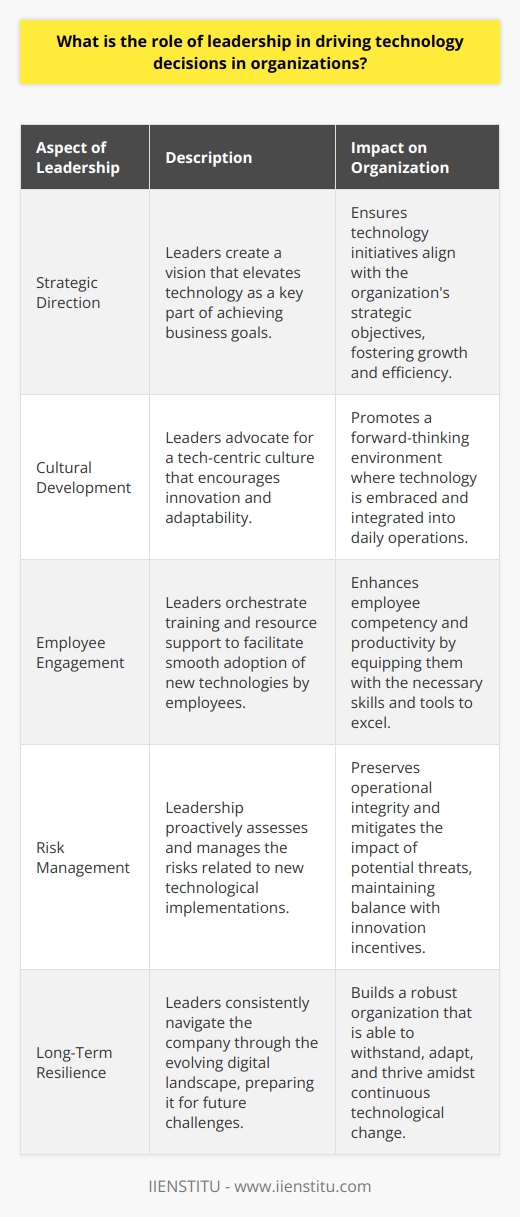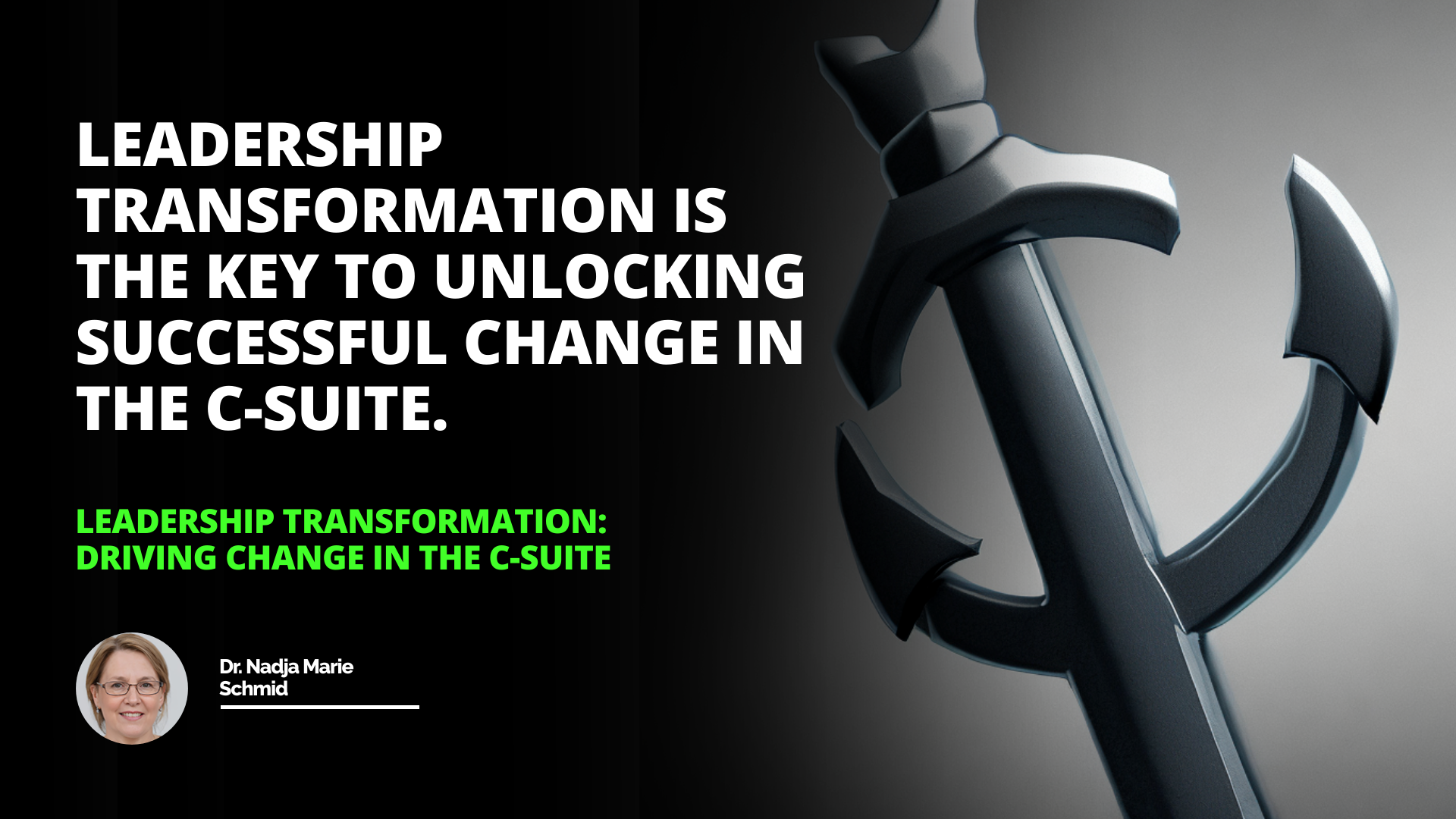
This article discusses the importance of transformation in the C-Suite to drive change and improve organizational performance. It outlines the different forms of transformation, such as developing a go-forward strategy and implementing new systems and processes. It explains the importance of understanding the organization's culture, structure, and techniques to drive organizational change. It also explains how to formulate and execute a plan of action to drive the desired change and overcome resistance to change.
Introduction
Transformation in the C-Suite
Different Forms of Transformation
Driving Change in the Organization
Overcoming Resistance to Change
Introduction: Transformation in the C-Suite is a critical part of organizational success. As C-suite executives are hired to drive change and improve performance, it is essential to understand the different forms of transformation and how to change the organization. This article will explore the various forms of transformation, the importance of driving change in the organization, and how to overcome resistance to change.
Transformation in the C-Suite
Transformation in the C-Suite is a change process designed to improve an organization's performance. It is a process often led by C-suite executives to drive change and improve performance. This process can take many forms, from developing a go-forward strategy for the organization to implementing new enterprise resource planning (ERP) systems and associated business processes.
Different Forms of Transformation
Transformation in the C-Suite can take many forms. The most common form of change is developing a go-forward strategy for the organization. This includes the development of a vision, mission, and goals for the organization, as well as a plan of action to achieve those goals. This process also involves the implementation of new systems and processes, such as ERP systems, as well as the development of new organizational structures and cultures.
Another form of transformation in the C-Suite is the implementation of change initiatives already predetermined in the company. This may involve significant cost reductions, implementing new systems and processes, or developing new organizational cultures.
Finally, transformation in the C-Suite can involve the development of new leadership skills and capabilities. This includes the development of further communication and collaboration skills, as well as the result of new problem-solving and decision-making skills.
Related Course: Leadership Course
Driving Change in the Organization
In order to drive change in the organization, C-suite executives must be able to understand the organization and its needs. This includes understanding the organization's culture, structure, and processes. It also includes understanding the organization's goals and objectives and its challenges and opportunities.
Once the C-suite executive clearly understands the organization, they must formulate a plan of action to drive the desired change. This plan must be tailored to the organization's specific needs and should consider the organization's culture, structure, and processes. The program should also include specific goals and objectives and a timeline for achieving those goals.
Finally, the C-suite executive must then execute the plan. This includes communicating the method to the organization, providing resources to support the program, and monitoring progress. The C-suite executive must also be prepared to adjust the project to ensure that the desired change is achieved.
Overcoming Resistance to Change
Resistance to change is a common issue in organizations. Therefore, C-suite executives need to be aware of the potential for resistance to change and to be prepared to address it.
One of the best ways to overcome resistance to change is to involve stakeholders in the process. This includes engaging stakeholders in developing the plan and allowing them to provide input and feedback. This will help ensure that the program is tailored to the organization's needs and supported by those affected by the change.
It is also essential to communicate the plan clearly and effectively. This includes providing clear and concise information about the program, its goals and objectives, and how it will impact the organization. It is also essential to ensure that the plan is communicated promptly.
Finally, it is essential to provide resources to support the plan. This may include training to ensure stakeholders are prepared to implement the plan and providing additional resources to help the project.
Conclusion: Transformation in the C-Suite is a critical part of organizational success. C-suite executives need to understand the different forms of transformation, the importance of driving change in the organization, and how to overcome resistance to change. By understanding these aspects of transformation, C-suite executives can ensure that their organizations successfully achieve their desired goals.
Leadership transformation is the key to unlocking successful change in the C-Suite.
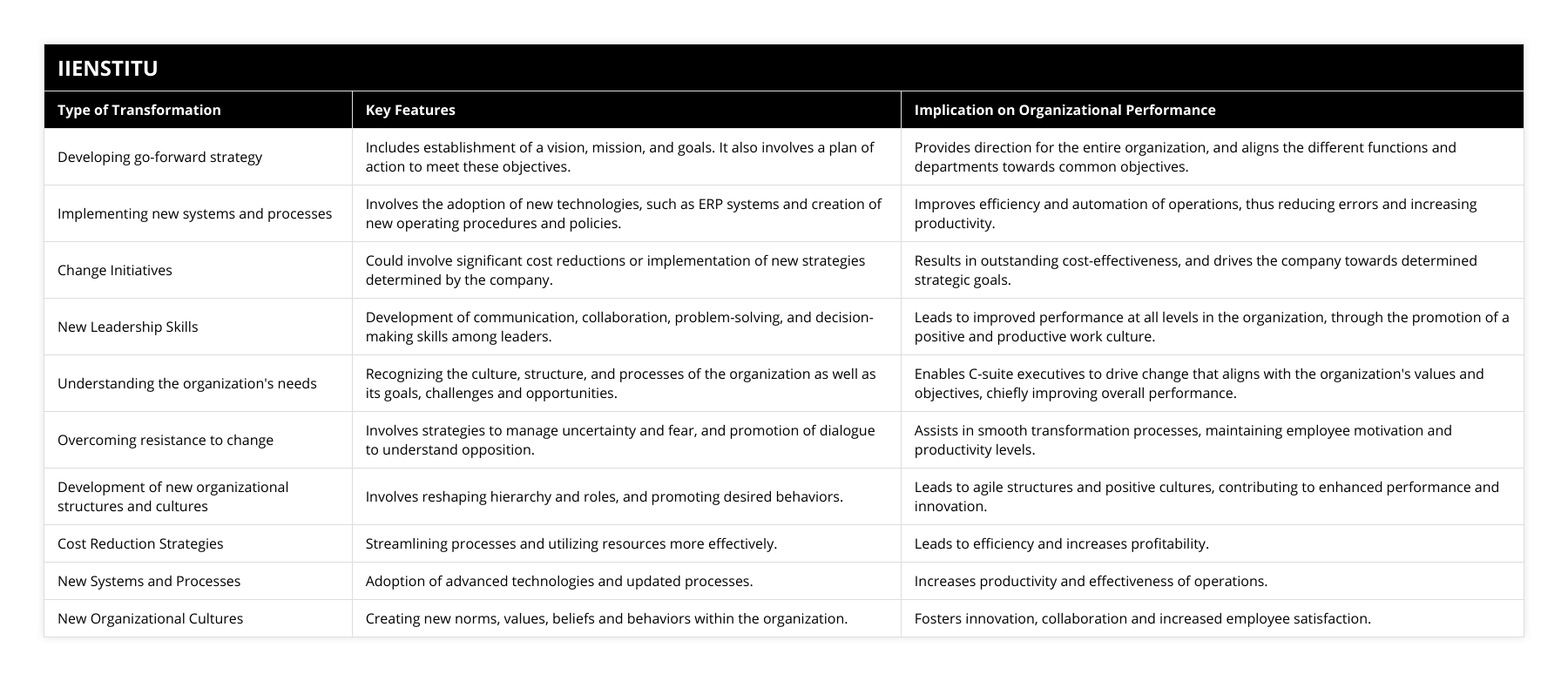
Frequently Asked Questions
What strategies can C-suite executives use to drive successful transformation in their organizations?
Organizational change is an inevitable part of any business. C-suite executives are responsible for driving successful transformation in their organizations, but this can be daunting. C-suite executives must employ a well-thought-out strategy to ensure that change initiatives are effective. This article will discuss five strategies C-suite executives can use to drive successful organizational transformation
The first strategy is to create a comprehensive change plan. C-suite executives need to develop a detailed plan that outlines the objectives and benefits of the transformation, as well as the resources and timeline for implementation. Developing a clear, concise, and realistic plan will help ensure the transformation is successful.
The second strategy is to communicate the change plan to all stakeholders effectively. C-suite executives must ensure that all stakeholders understand the objectives and benefits of the transformation, as well as their role in the process. Clear and frequent communication will help build trust and ensure stakeholders are on board with the proposed changes.
The third strategy is to empower employees to take ownership of the process. C-suite executives should provide employees with the resources and support they need to be successful. This includes providing training, access to necessary tools, and opportunities to give feedback. Empowering employees to take ownership of the process will help ensure a successful transformation.
The fourth strategy is to measure progress and make adjustments as needed. C-suite executives should regularly assess the progress of the transformation and make adjustments as needed. This will help ensure that the transformation is on track and that any issues are addressed promptly.
The fifth strategy is to recognize and reward success. C-suite executives should recognize and reward stakeholders for making the transformation successful. This will help build morale and ensure that employees remain motivated and engaged.
In conclusion, C-suite executives must employ a well-thought-out strategy to ensure successful transformation initiatives. The strategies outlined in this article, including creating a comprehensive change plan, communicating the plan to stakeholders, empowering employees to take ownership of the process, measuring progress, and rewarding success, can help C-suite executives drive successful transformation in their organizations.
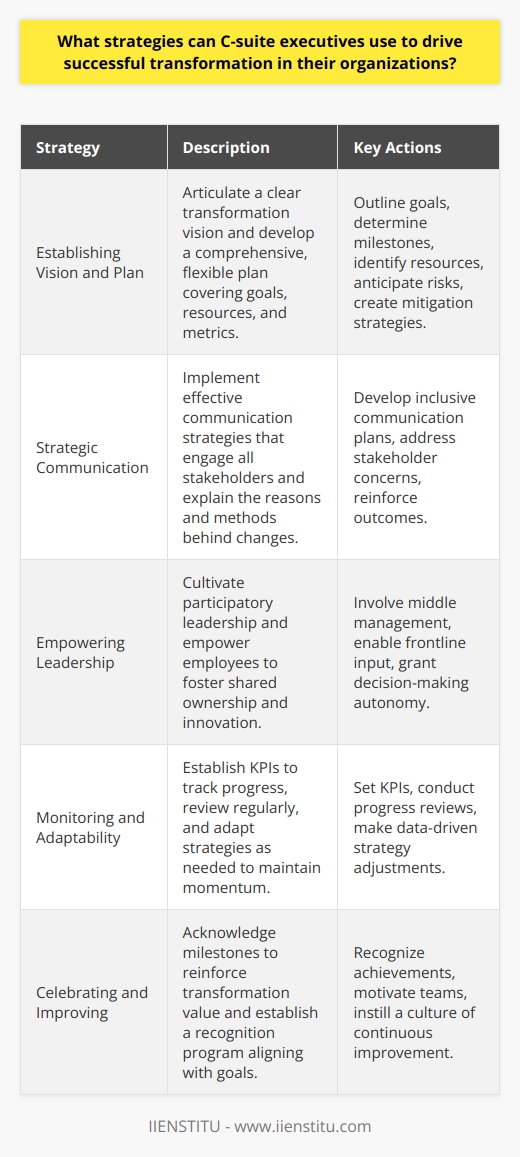
How can C-suite executives ensure that their transformation efforts are sustainable over time?
Companies are increasingly looking to their C-suite executives to lead organizational transformation efforts in today's fast-paced business world. However, these efforts are only effective if they are sustainable over time. To ensure that transformation efforts remain successful, C-suite executives must focus on four key areas: developing a clearly defined and actionable strategy, creating a culture of continuous improvement, building an agile and resilient organization, and cultivating effective stakeholder relations.
First, C-suite executives should develop a clearly defined and actionable strategy to guide their transformation efforts. A strategy provides a roadmap for the organization, ensuring that all stakeholders, including the C-suite, are aligned and working together to achieve the desired outcomes. To ensure that the strategy is actionable, the C-suite should ensure that there are measurable goals, metrics, and timelines, as well as the resources and budget needed to execute the plan.
Second, C-suite executives should create a culture of continuous improvement in their organization. This means creating an environment where employees are encouraged and supported to identify and address problems and opportunities and where new ideas and solutions are welcomed. C-suite executives should ensure that they are actively engaged in this process, encouraging employees to think outside the box and provide feedback on the transformation initiatives.
Third, C-suite executives should build an agile and resilient organization. An agile organization can quickly and easily adapt to changing conditions and rapidly respond to new opportunities. Resilience is the ability of the organization to bounce back from adversity and to remain agile in the face of change. C-suite executives should focus on developing processes and practices that foster an agile and resilient organization.
Finally, C-suite executives should cultivate effective stakeholder relations. This involves engaging stakeholders in the transformation process and cultivating relationships with key external stakeholders such as customers and partners. Effective stakeholder relations are essential for ensuring that the transformation efforts are successful and sustainable over time.
In conclusion, C-suite executives must focus on developing a clearly defined and actionable strategy, creating a culture of continuous improvement, building an agile and resilient organization, and cultivating effective stakeholder relations to ensure that their transformation efforts remain successful and sustainable over time. By focusing on these four key areas, C-suite executives can ensure that their transformation efforts are successful and sustainable.
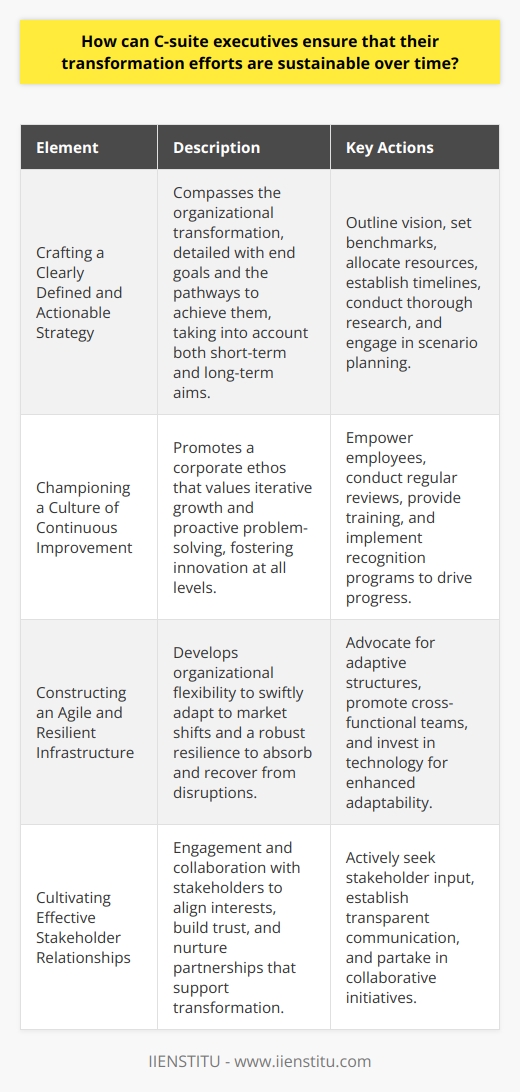
What are the key elements of successful leadership transformation in the C-suite?
The C-suite is the highest level of management in any organization, and successful leadership transformation at this level significantly impacts the organization’s success and long-term viability. Therefore, C-suite executives must understand the key elements of successful leadership transformation.
The first element of successful leadership transformation in the C-suite is vision. C-suite executives must have a clear vision of the organization’s goals and objectives and be able to articulate them to their teams. They must also be able to inspire their teams to work towards achieving these goals. Once the vision is established, C-suite executives must develop a strategy for achieving the goals. This should include a detailed action plan with measurable milestones and timelines.
The second element of successful leadership transformation is effective communication. C-suite executives must communicate their vision and strategy to their teams clearly and concisely. They must also be able to listen to their teams, provide feedback, and adjust the strategy as needed. This requires strong interpersonal skills, including motivating and inspiring team members.
The third element of successful leadership transformation is collaboration. C-suite executives must be able to work with their teams to develop innovative solutions to problems and explore new opportunities. They must also be able to delegate tasks and responsibilities to their teams in a way that encourages them to be engaged and productive.
The fourth element of successful leadership transformation is execution. C-suite executives must be able to lead their teams in executing the vision and strategy. This includes providing the necessary resources and guidance to ensure the strategy is executed effectively. It also requires measuring progress and adjusting the strategy as needed.
Finally, C-suite executives must be able to foster a culture of innovation and continuous improvement. They must be able to inspire their teams to think creatively and develop new ideas. They should also be able to create an environment where team members feel safe to take risks and challenge the status quo.
In summary, successful leadership transformation in the C-suite requires vision, effective communication, collaboration, execution, and a culture of innovation and continuous improvement. C-suite executives must be able to set a clear vision, communicate it to their teams, collaborate to develop a strategy, execute it, and foster a culture of innovation and continuous improvement. Together, these elements can help ensure that the organization is successful and sustainable in the long term.

What is the role of leadership in driving digital transformation?
Role of Leadership in Catalyzing Change.
Leadership plays a pivotal role during digital transformations. Stalwart leaders have the capacity to visualize the future of their organization in a digital world.
Strategic Planning Benefits.
Strategic planning is a vital aspect they perform. They devise and implement a roadmap to pilot the transition from conventional methods to a digital platform. This planning balances potential risks with potential gains.
Importance of Communication.
Effective leaders ensure seamless communication. They convey the necessity of this transition to employees in terms understandable to all. This promotes a cohesive understanding and resolute acceptance of digital change throughout the organization.
Driving Innovation and Experimentation.
Leaders foster a culture of innovation. They encourage team members to brainstorm and experiment with new ideas, tools, and strategies. Such an atmosphere hastens digital transformation by driving each member to contribute to its success.
Setting Targets and Tracking Progress.
They set clear targets and track progress, ensuring smooth progress toward the organization's digital goals. Monitoring helps to identify challenges early, permitting prompt corrective measures.
Leaders As Role Models.
Leaders embody the change they want to see. They readily adapt to new methodologies, technologies and set an inspiring example for their team. Their resolve stimulates other members to adapt faster to the digital transition.
In Closing.
In essence, leadership serves as an impetus in driving digital transformation. Their powerful vision, strategic planning, effective communication, encouragement of innovation, rigorous tracking, and adaptability fuel the transition from traditional practices to a digital paradigm. Through their vital role, leaders ensure the digital transformation aligns with the organization's objectives and enhances performance.
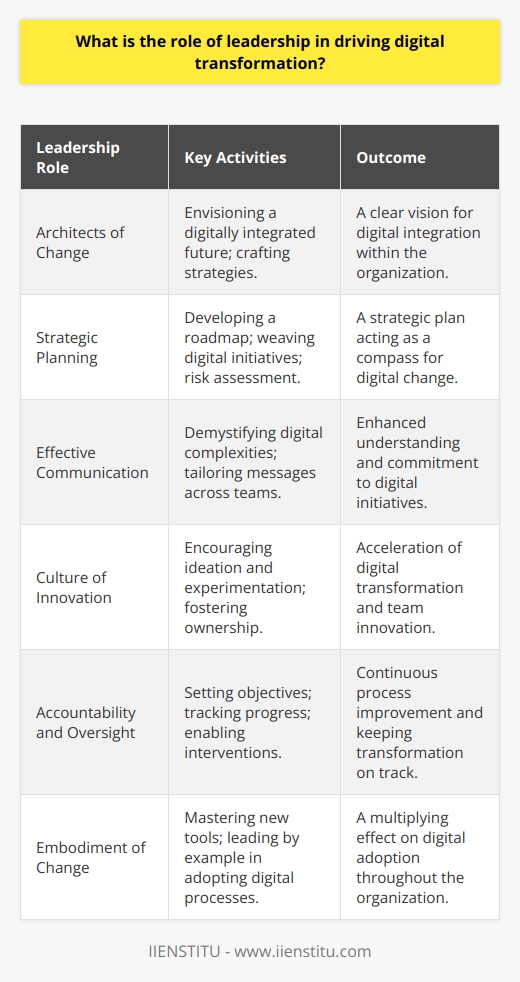
How do you drive transformational change?
Understanding Change Needs
Driving transformational change begins with understanding the organization's current status and where it aims to be. With clear objectives defined, strategizing for change becomes smoother.
Developing a Coherent Strategy
Developing a coherent, well-thought-out strategy is vital for successful change implementation. The strategy covers several aspects including timelines, communication plan, roles and responsibilities, and risk identification and mitigation.
Building Strong Leadership Support
Leadership support aids in achieving change. Lead figures facilitate the smooth adoption of change - demonstrating the benefits, addressing concerns, promoting a supportive culture, and managing resources effectively.
Preparing Stakeholders
Stakeholders must be ready to adapt to change. Preparation includes educating them about potential changes, the reasons behind them and the advantages of adopting them. This helps in securing their continued support and cooperation.
Managing Expectations
Managing expectations, both internally and externally, helps in smoothing the transition. This involves sharing a clear direction, potential challenges and the expected impact of the change.
Implementing Change
For continuous and successful change, implementing the plan diligently and consistently is paramount. Regular monitoring and adjustments according to feedback improve the efficiency of implementation.
Communicating Consistently
Effective communication ensures everybody in the team understands their role in driving change. Regular, clear, and concise communication reduces confusion and misinformation.
Training and Development
Training is essential for stakeholders to grasp the new processes and systems being implemented. Dual benefits arise from training – it increases knowledge and reinforces the importance of the transformational change.
Addressing Resistance
Resistance to change is inevitable. Hence, it’s crucial to tackle it via communication, training, and by providing assistance and reassurance.
Monitoring Progress
Monitoring and reviewing progress to assess the impact of the change is essential. This helps in making adjustments and improvements as needed.
Realizing transformational change is a complex process. It requires deep understanding, strategic planning, effective communication, and stakeholders' preparedness and support. Regular reviews to monitor progress and mitigate risks enhance the chances of success. Implementing transformational change is not an instant process but requires patience, perseverance and a resilient approach.

What is the role of leadership in driving technology decisions in organizations?
Understanding Leadership and Technology
Leadership plays a pivotal role in driving technology decisions within organizations. It primarily sets the direction for technological advancements. Leaders involve themselves in tech decisions by identifying tech-driven opportunities that align with the organization's strategic goals.
Strategic Importance of the Tech Decisions
Lines of communication regarding technology trends and relevance evolve around effective strategic leadership. Leaders must stay knowledgeable about current and emerging technologies. Awareness helps leaders maneuver tech-related decisions responsibly. It aids in understanding the technological aspects critical to the organization's workflow, productivity, and objectives.
Tech Decisions and Organizational Culture
Leadership's role extends beyond making choices about technology. They also shape the organization's tech culture. They establish an environment that promotes exploration and adoption of relevant technologies. Leadership does this all while ensuring alignment with core business strategies. Successful leaders nurture a culture that isn't averse to technology. Instead, leaders encourages the understanding and utilization of technological capabilities.
Leadership, Technology, and Employee Enablement
Leaders significantly influence employee responses to technology initiatives. They pave the way for acceptance and efficient use of new technologies. Clear communication of technology's relevance and potential benefits foster employee acceptance. Effective leaders make employee training and resources available. The goal is to ease transitions and enhance new technology's productivity potential. This approach ensures maximum uptake and utilization of new technologies.
Balancing Risk and Innovation
Leadership is also responsible for balancing technological risks. Leaders assess potential problems while pursuing innovative tech solutions. Assessing and mitigating risks encourages an environment that balances innovation and stability. Responsible tech decisions allow organizations to reap substantial returns from their technology investments.
In conclusion, leadership's role in driving technological decisions is integral. The decisions leaders take not only determine the technological direction of the organization but also shape its culture, influence employee acceptance, and balance risk and innovation.
